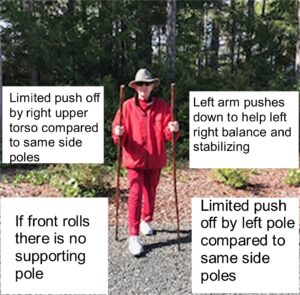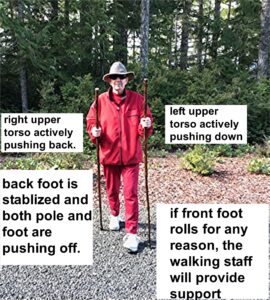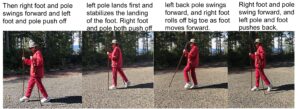Skip to content
The Strenuousness (or sweat factor) of exercise is not the goal. Having a life-long exercise regime that never causes damage to muscles and joints is the goal.
Realistically, what can reduce the amount of exercise may not only be a lack of motivation but painful ankles, knees, back, etc. Often this can be due to lack of good instruction as to the biomechanics (research term 🙂 involved in an activity before you put in the time and effort that leaves you injured.
Unfortunately, in 2021 most “fitness” centers only focus on aerobic, high energy, work-outs. This can lead to injuries as well as feeling that you cannot exercise because you cannot keep up. So, you really have to have a strong “I am not comparing myself to others” attitude if you use these facilities. And be sure to get the trainers there to show you how to correctly use what they have.
Until “fitness” center become far more diverse they can have a place, but a more limited place in your exercise choices. Fitness centers need to provide for high energy and low energy days (one day you may do a moderate aerobic workout, another day you may just want to do a long gentle stretching routine, yoga in which you may want to use supplied pillows for support. Counter to how almost all yoga is taught, the position needs to be reasonably comfortable so that you can focus, release muscle groups and slowly “become one” with the position. (This information comes from the earliest teachings on (hatha) yoga. Somewhat like aerobics, people began saying that twisting and torqueing joints was comfortable for them, and everyone who couldn’t do that had disappointing times. Tai Chi is a wonderful movement meditation. But, if needed, modify movements if you find too much muscle strain or imbalance.
When you are “working on/with” your body, “pushing” activities need to be balanced by relaxing activities. And despite all the hype, gentle stretching, yoga, tai chi, are far more helpful at the beginning. Then, moderate aerobic activities can be added. No matter what, your knees have only so many years of jogging before pain sets in. The same can happen with any high impact/high exertion activities. Looking physically great at 30, and facing knee, shoulder, or hip replacement at 50 is not the optimum choice.
If you have a trusty exercise program, and learned the correct biomechanics, the other consideration is if it includes all your muscle groups (research what the major muscle groups are). If a sport is your favorite exercise, then find out what muscle groups are used, and which ones are not. Also find out what the possible injuries can occur in that sport, and how to prevent them. Become knowledgeable about all forms of exercise, and provide yourself a well-balanced one that personally works for you. Your body, your life, so learn as much as you can, and truly “be a pro.”
Walking with Walking staffs is one of the best options, if not the best because walking is a human activity that dates as far back as any humans activity. When walking staffs are used, up to 94% of your major muscle groups are used in a low impact activity — doesn’t get much better than that!
Your skeletal-muscular system (if you have not research the “systems” of the body, it is so worth the effort.) has developed to “support” walking. So, why not use what is rather natural. However, over 90-98 percent of people have never been taught how to walk. Years of walking incorrectly will compromise the joints involved. For a presentation on walking correctly, first see the section on walking in Postural Alignment.
Secondly, there is a correct way of walking that minimizes joint stress, and maximizes joint efficiency. So, take time to learn to walk — I had to. 🙂
When walking without staffs, the arms swing is a gentle arc opposite to the legs. Right arm swings out with left leg, and left arm then swings out as right leg steps. Almost all videos that show how to use “trekking poles,” or “walking staffs, utilize this same alternate arm to leg pattern.

However, when adding “trekking poles” and “walking staffs, you get better muscle use of the upper torso muscles by using the staff with the same leg — the front toe and the arm push down through the staff work together. You also have better balance as the staff swinging forward faster than the leg hits slightly before the foot. This can really spare you falls and twisted ankles . So, the counter balance to leg in the arm swing during walking is replaced by stabilizing with the poles or staffs. See photo below for an example of how the foot could roll, but the staff is there to lean on, and minimize your body coming down on that rolled foot.

Here is what same leg-arm use looks like from the profile:

Just keep the leg and arm in unison, with both pushing back as you roll off your big toe, and the pole landing slightly before the foot when you step forward so that the pushing down of the pole stabilizes the landing of the foot.
Hiking trails allows you both the benefits of walking with staffs plus increasing your relationship with nature. Having a friend or two is really the safest way to “take to the trails.” Also, now many trail maps provide the elevation gain in the hike. Start with short hikes: 1-2 miles with little increase in elevation. You can increase from there.
Swimming has benefits for total body exercise because swimming takes the gravity pull on the joints away due to water buoyancy. The benefits of swimming as a total exercise increase if you learn the different swim strokes and swim laps with all of them. The disadvantage of swimming is finding a swimming pool that is affordable, accessible, and not overcrowded, which can make swimming at your own pace difficult. The time allotment for travel, changing, showering, swimming, showering, drying hair if necessary, and then travel back adds up. All of these can be limiting factors. Also, for bone density, swimming needs to be balanced by walking. (research bone density and exercise 🙂
Dancing is coming back in various forms. Dances that actually have dance steps, are the best because there is mind/body focusing; and the unity of this has its own benefits to experience “oneness.” Taking classes adds expense, but still is a good health investment. A good teacher will teach you the correct ways to dance while protecting your joints! But, do not be limited to dances others have created:
When at home… put your favorite music on, through speakers or headphones, and create your own dances to the music. This blends exercise with being creative. Feel free to improvise each time. Dancing, like walking with staffs uses almost all of your skeletal-muscular system, and not only takes you out of your intellect, but can be highly creative, which is very beneficial to your wellness. And, it is fun!
Bicycling is often a good life time exercise. The bicycle provides support for the upper torso, and places the back in a good position for most people — sometimes even for those with lower back pain. The lower torso is spared gravity’s impact on the joints with the use of the bicycle pedals. Bicycling limits upper torso development. Bicycling is often more dangerous as it occurs on streets with other vehicles. Also, if bicycling occurs in heavy traffic areas, breathing vehicle exhaust is not healthy. However, more and more bicycle trails are being developed. Also, finding less traveled neighborhood streets is possible. Bicycling on trails using trail bicycles have dangers from falls. These areas really are not feasible for life-long exercise. Overall, bicycling, even with its upper torso development limitations and vehicle dangers, with care and attention can become life-long exercise.
Fitness Centers — A summary of Pros and Cons
Pros: American fitness centers have lots of treadmills, stationary bicycles, and even aerobic sessions. The best use of these is to take the time to be trained on the equipment and make use all that is offered. The variety of exercise develops more muscle groups, and lessens the chances of straining certain joints. Those are the pros of fitness centers — they typically offer a good variety of exercise equipment.
Now some warnings of the cons:
A special warning about jogging, even on treadmills that soften the impact on the feet. Unlike walking where one foot is always stable on the ground, jogging requires having both feet off the ground at some point in the stride, and that increases the impact of all your body weight landing on one foot. If you like to jog, and have learned to jog correctly, treadmill jogging is much better on your joints than jogging on cement or uneven surfaces or on busy streets with vehicle fumes that you breath.
Another con is that if you go in and only use the strengthening and cardio-vascular equipment. Use of this equipment needs to begin with a gentle “warm up” session. Typically, a light warm up is light stretching and low impact swings of arms, legs, shoulders, etc. This is the preparation you want before strenuous exercise. Then, have a well-rounded “work out” that finishes with stretching all muscle groups. Again, being taught how to stretch is usually necessary, as a person can “pull a muscle” when jerking rather than very slowly stretching a muscle group. Not stretching after strenuous exercise is not advised. Use the time while gently, but continually, lengthening muscle groups to clear your mind, and focus on the muscles being stretched as a meditation focus.
Another con: If there are anerobic work out sessions, skip them. There are just too many dangers to those.
And, finally, a con is the attitude of “the more the better.” So, if you are in an aerobic class that is going too quickly for you to keep up, do not allow yourself to be pushed into trying to keep up. This is when “strains,” “sprains,” and even minor injuries can happen. The whole idea of “more is better” needs to be changed to “don’t push it.” This is counter to what most all fitness centers endorse, but you only have one body, and to err on the side of moderation may allow you a life-long capability to exercise.
If you just have had too many bad experiences with physical activities
Use stairs instead of elevators where practical and possible. In the biomechanics of this, place your whole foot on each step, and make sure your knee is over your toes. Also running up the stairs is not the idea as much as a walking up the stairs where your entire foot is placed on the stair. Plantar Fasciitis Is a painful and chronic condition that can develop if you run or quickly walk up stairs on just the front of your foot, instead of walking with your full foot landing on each stair. Walking up stairs as exercise, while being mindful of your posture and foot placement gives an extra benefit from walking on level surfaces. However, you lose the benefit of using your upper torso as with walking staffs.
What is advantageous about walking up stairs to wherever you need to get to is you get to where you are going and have gotten in some good exercise. With the increased oxygen exchange during the walking, your mind will can be more focused and more alert; a nice benefit. If you have on sweaters or suit jackets, you might want to carry instead of wear them; using stairs does increase body temperature. One last note on using the stairs is that many places have placed “fire doors,” which do not let you exit. *~* So check this out. Interestingly, walking downstairs, like hiking down hill, is more strenuous on your knees, and not recommended long term. So check and is if exiting is possible and only walk up stairs. Hopefully, places with stairs will find a way to keep stairways open and fire safe.
If All Else Fails
a) Always park your vehicle at towards the end of a parking lot. A benefit is that you get to skip the “trying to find a parking space” experience, and your vehicle is less likely to get scraped; yet you and your vehicle are still safely close to others. If you are carrying stuff in or out, your arms get some exercise too. (Carrying bags of close to equal weight in each hand is so much better on your body than carrying one heavy bag.) And, if your have a heavy load, use a cart. Pushing the empty cart back adds to your exercise. Exercise, not over-burdening your body, is the goal.
b) When possible, take the long way to and from the kitchen, and even take a couple of laps around when going for snacks. A couple of laps around your floor space is better than nothing. Also, remember, if you walk or exercise before or after eating you might feel better, and maybe even reduce the guilt of eating instead of exercising.
Really Being Bold … If the weather is nice and you have a meeting with one other person, suggest taking a walk as you talk. Brain Research indicates that your brain will probably function better while walk-talking. (A reminder here that if you have not reviewed Postural Alignment now is a good time to do so.
The “Life-time” Rule … Try to have, or include, physical exercise activities that you can do throughout your life. Using weights, jogging, or strenuous sports eventually undermine certain joints in your body. Then, you are left with chronic pain and limited options. Dancing, walking with staffs, bicycling on designated trails (bicycling or walking on busy streets and highways means you are not only breathing polluted air, but also at risk from motorized vehicles), are the sort of “life-time” exercises. “Fitness aerobic” classes can quickly demoralize your interest in exercising if you find you cannot keep up, or they just take too much out of you. This really is important, because if disappointment, overuse, or injury takes way strenuous activity, you may lose interest in any exercising. If you do not have this in place, there can be an inner disappointment and/or guilt that leaves a, “I am no longer exercising, I ‘should’ get back but I can’t. I think I will see what is in the refrigerator, all of the sudden I feel hungry.” (Try to take the long way to the kitchen – see b above… 🙂
Whatever exercise you do choose , try to stay active for at least 20 minutes (you may want to take those stairs a little slower…). If you create a song list for moving to, or drumming to, make sure you can eventually get to that 20 minute mark, and then slowly, perhaps song by song, increase to about 60 minutes — you can always end at 20, and know you got in your due time for the day. What undermines exercise, second to injury, is a lack of time. If you find you are always rushing just to get through the day, you rightfully see that you have no time to exercise. Use good discernment, and decide that some demands are going to have to come second to your health, and begin with simple physical exercise (which includes stretching). Remember if exercising was easy and profitable, more would find the time. Well, exercising is significantly profitable compared to health care costs, and with creativity you can find easy ways to include simple exercise. And, once you know basic biomechanics develop your creativity by being creative in finding your individualized forms of exercise. Remember you are unique, and best know what works best for your body.


